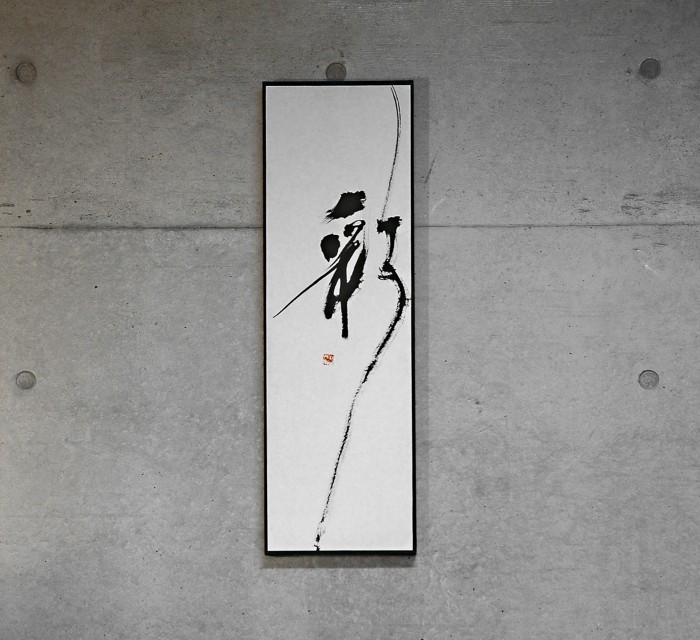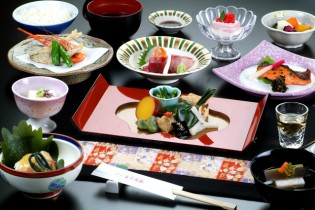Sumi-e Calligraphy Art by Houso Oguri (IRODORI; colouring, brilliance)

About this Piece
Irodori meaning “colouring and brilliance”, has a rather positive, even entrepreneurial spirit to it, let us explain…
Irodori meaning “colouring and brilliance”, has a rather positive, even entrepreneurial spirit to it, let us explain…
Interestingly, Irodori actually has a place in fine Japanese restaurants. “Irodori (coloring) Agriculture” is a way of gathering various plants in a town and selling them as tsumamono (garnish) – any leaf, branch, flower, etc. can be placed as a decoration to a traditional Japanese dish.
It is a widely known example of a successful business for Japan’s mountainous farming villages as it utilizes the natural resources of area.
Broadly speaking Irodori represents a passion or zeal for life. The gentle touch demonstrated here evokes a feeling of well being and cheer. Celebrating the beauty of life, and the opportunities life bestows upon us if we seek them out.
The simple and elegant black found in this piece compliments the combination of colours in any room. This Sumi-e painting’s skillful ‘dance of colours’, represented by long and vibrant brushstrokes, elegantly stretch from the top to the bottom of the canvas.
This art piece comes mounted on a wood board with a black border. Every Sumi-e painting is an original by Houso Oguri made exclusively for Unique Japan. She will prepare a piece for you within approximately two weeks upon order confirmation.
Size: (22cm x 68cm / 8.7in x 26.8in)
Something special…
About Sumi-e
Throughout its 2000-year long history, Sumi-e began with highly-disciplined monks trained in the art of concentration, clarity, and simplicity. Sumi-e has been held in the highest esteem and became a powerful way to instill the values of Bushido, the Samurai Code of Conduct or Moral Principles.
Throughout its 2000-year long history, Sumi-e began with highly-disciplined monks trained in the art of concentration, clarity, and simplicity. Sumi-e has been held in the highest esteem and became a powerful way to instill the values of Bushido, the Samurai Code of Conduct or Moral Principles.
For the swordsman, composure on the battlefield had its artistic parallel in the calm and tranquility essential before the fearless release of a brush stroke. Embodying the honorable spirit (tamashi) of ancient warrior codes, Sumi-e was a metaphor for the fleeting world of the courageous Samurai swordsman.
The sublime simplicity of Sumi-e paintings convey a sense of serenity and peace like no other art form. Sumi-e, meaning “charcoal drawing”, is an ancient Japanese art that uses ink derived from densely packed charcoal ash from bamboo or pine. Sumi-e paintings typically capture the spirit of the subject, rather than its appearance. This elegant austerity reflects sumi-e’s relationship with the tranquility of Zen Buddhism.
Artist Biography
Oguri-san was born in 1948 and began training in calligraphy at the tender age of six. As a university undergrad, she specialized in the art of Japanese calligraphy. Following her studies, Oguri-san chose to devote her life to perfecting the art of sumi-e (charcoal drawing), inspiring both young and old with her passion and skill.
Oguri-san was born in 1948 and began training in calligraphy at the tender age of six. As a university undergrad, she specialized in the art of Japanese calligraphy. Following her studies, Oguri-san chose to devote her life to perfecting the art of sumi-e (charcoal drawing), inspiring both young and old with her passion and skill.
A trained professor of calligraphy, Oguri-san also teaches the ancient Japanese art form of ink derived from densely packed charcoal ash. Not only do her art pieces express Zen and calm, but anyone fortunate enough to speak with Oguri-san and share her life experiences also feels a warm and immediate sense of peace.
Her work has appeared in numerous private collections in Japan, and most recently in the Tokyo showroom of exclusive kitchen maker, Poggenpohl.
Special Orders
If you are interested in a custom made piece at most any size in any Japanese kanji, for a special location such as a business reception area, restaurant, school, home, etc. please contact us.
If you are interested in a custom made piece at most any size in any Japanese kanji, for a special location such as a business reception area, restaurant, school, home, etc. please contact us.




